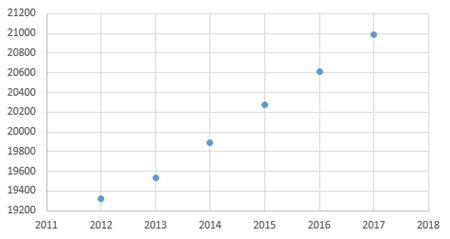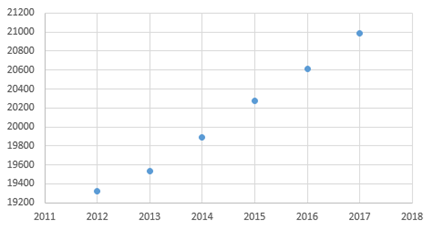
a.
The
| Year | Population ( in thousands) |
| 2012 | 19321 |
| 2013 | 19533 |
| 2014 | 19893 |
| 2015 | 20271 |
| 2016 | 20612 |
| 2017 | 20984 |
a.
Answer to Problem 53RE
The obtained graph is defined as,

Explanation of Solution
Given Information:
The table is defined as,
| Year | Population ( in thousands) |
| 2012 | 19321 |
| 2013 | 19533 |
| 2014 | 19893 |
| 2015 | 20271 |
| 2016 | 20612 |
| 2017 | 20984 |
Consider the given table,
| Year | Population ( in thousands) |
| 2012 | 19321 |
| 2013 | 19533 |
| 2014 | 19893 |
| 2015 | 20271 |
| 2016 | 20612 |
| 2017 | 20984 |
Draw the points on the plane to make the scatter plot.

Therefore, the above graph is required scatter plot.
b.
To calculate: The slope of the secant line
b.
Answer to Problem 53RE
The slopes are
And, the function is not discontinues
Explanation of Solution
Given information:
The table is defined as,
| Year | Population ( in thousands) |
| 2012 | 19321 |
| 2013 | 19533 |
| 2014 | 19893 |
| 2015 | 20271 |
| 2016 | 20612 |
| 2017 | 20984 |
Formula Used:
If
Calculation:
Consider the given table,
The initial point
Now, find the slope of the point
Now, find the slope of the point
The
Now, find the slope of the point
The
Therefore, the obtained slopes are
c.
To calculate: The slope of the secant line
c.
Answer to Problem 53RE
The slopes are
Explanation of Solution
Given information:
The table is defined as,
| Year | Population ( in thousands) |
| 2012 | 19321 |
| 2013 | 19533 |
| 2014 | 19893 |
| 2015 | 20271 |
| 2016 | 20612 |
| 2017 | 20984 |
Formula Used:
If
Calculation:
Consider the given table,
The initial point
Now, find the slope of the point
Now, find the slope of the point
The
Now, find the slope of the point
The
Now, find the slope of the point
The
Now, find the slope of the point
The
Now, add all the averages and divide by number of average.
Therefore, the obtained average is
d.
To calculate: The instantaneous slope at 1 July 2013.
d.
Answer to Problem 53RE
The slopes are
Explanation of Solution
Given information:
The table is defined as,
| Year | Population ( in thousands) |
| 2012 | 19321 |
| 2013 | 19533 |
| 2014 | 19893 |
| 2015 | 20271 |
| 2016 | 20612 |
| 2017 | 20984 |
Formula Used:
If
Calculation:
Consider the given table,
The initial point
Now, find the slope at 1 July 2013.
Therefore, the obtained slope is 212 thousand in year.
e.
The reason that why linear growth may or may not be a bad assumption over longer periods of time.
e.
Answer to Problem 53RE
The linear asuumation is incorrect.
Explanation of Solution
Given information:
The table is defined as,
| Year | Population ( in thousands) |
| 2012 | 19321 |
| 2013 | 19533 |
| 2014 | 19893 |
| 2015 | 20271 |
| 2016 | 20612 |
| 2017 | 20984 |
Consider the given table,
As it can be observed that the slope between all the years is not same as calculated in previous part. For each year the slope is different this implies that the growth of the population in each year is different. The slope is increasing in each year.
And for the linear growth the slope should be same in each year. So it is not possible to calculate the correct estimates of the population in 2020 by using the linear equation. Thus, the linear model may be a bad assumption over the longer periods of time to calculate the population in any year.
Therefore, the linear model is incorrect.
Chapter 1 Solutions
CALCULUS-W/XL ACCESS
- Points z1 and z2 are shown on the graph.z1 is at (4 real,6 imaginary), z2 is at (-5 real, 2 imaginary)Part A: Identify the points in standard form and find the distance between them.Part B: Give the complex conjugate of z2 and explain how to find it geometrically.Part C: Find z2 − z1 geometrically and explain your steps.arrow_forwardA polar curve is represented by the equation r1 = 7 + 4cos θ.Part A: What type of limaçon is this curve? Justify your answer using the constants in the equation.Part B: Is the curve symmetrical to the polar axis or the line θ = pi/2 Justify your answer algebraically.Part C: What are the two main differences between the graphs of r1 = 7 + 4cos θ and r2 = 4 + 4cos θ?arrow_forwardA curve, described by x2 + y2 + 8x = 0, has a point A at (−4, 4) on the curve.Part A: What are the polar coordinates of A? Give an exact answer.Part B: What is the polar form of the equation? What type of polar curve is this?Part C: What is the directed distance when Ø = 5pi/6 Give an exact answer.arrow_forward
- New folder 10. Find the area enclosed by the loop of the curve (1- t², t-t³)arrow_forward1. Graph and find the corresponding Cartesian equation for: t X== y = t +1 2 te(-∞, ∞) 42,369 I APR 27 F5 3 MacBook Air stv A Aa T 4 DIIarrow_forwardMiddle School GP... Echo home (1) Addition and su... Google Docs Netflix Netflix New folder 9. Find the area enclosed by x = sin²t, y = cost and the y-axis.arrow_forward
- 2. Graph and find the corresponding Cartesian equation for: (4 cos 0,9 sin 0) θ ε [0, 2π) 42,369 I APR 27 3 MacBook Air 2 tv A Aaarrow_forward30 Page< 3. Find the equation of the tangent line for x = 1+12, y = 1-3 at t = 2 42,369 APR A 27 M . tv NA 1 TAGN 2 Aa 7 MacBook Air #8arrow_forwardEvaluate the following integrals as they are writtenarrow_forward
- Calculus lll May I please have the blank lines completed, and final statement defined as a result? Thank you for the support!arrow_forward3. Consider the polynomial equation 6-iz+7z² - iz³ +z = 0 for which the roots are 3i, -2i, -i, and i. (a) Verify the relations between this roots and the coefficients of the polynomial. (b) Find the annulus region in which the roots lie.arrow_forwardForce with 800 N and 400 N are acting on a machine part at 30° and 60°, respectively with the positive x axisarrow_forward
 Calculus: Early TranscendentalsCalculusISBN:9781285741550Author:James StewartPublisher:Cengage Learning
Calculus: Early TranscendentalsCalculusISBN:9781285741550Author:James StewartPublisher:Cengage Learning Thomas' Calculus (14th Edition)CalculusISBN:9780134438986Author:Joel R. Hass, Christopher E. Heil, Maurice D. WeirPublisher:PEARSON
Thomas' Calculus (14th Edition)CalculusISBN:9780134438986Author:Joel R. Hass, Christopher E. Heil, Maurice D. WeirPublisher:PEARSON Calculus: Early Transcendentals (3rd Edition)CalculusISBN:9780134763644Author:William L. Briggs, Lyle Cochran, Bernard Gillett, Eric SchulzPublisher:PEARSON
Calculus: Early Transcendentals (3rd Edition)CalculusISBN:9780134763644Author:William L. Briggs, Lyle Cochran, Bernard Gillett, Eric SchulzPublisher:PEARSON Calculus: Early TranscendentalsCalculusISBN:9781319050740Author:Jon Rogawski, Colin Adams, Robert FranzosaPublisher:W. H. Freeman
Calculus: Early TranscendentalsCalculusISBN:9781319050740Author:Jon Rogawski, Colin Adams, Robert FranzosaPublisher:W. H. Freeman
 Calculus: Early Transcendental FunctionsCalculusISBN:9781337552516Author:Ron Larson, Bruce H. EdwardsPublisher:Cengage Learning
Calculus: Early Transcendental FunctionsCalculusISBN:9781337552516Author:Ron Larson, Bruce H. EdwardsPublisher:Cengage Learning





